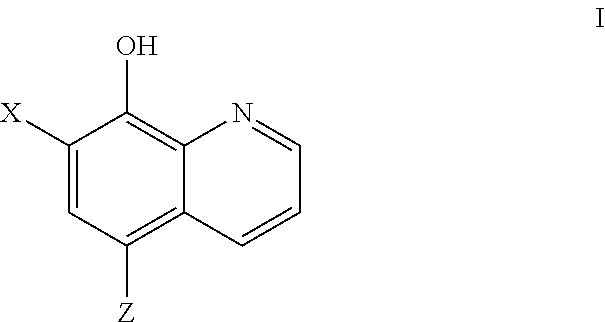COMT Inhibiting Methods and Compositions
a technology of catecholomethyltransferase and inhibiting methods, which is applied in the field of compounds and pharmaceutical compositions, can solve the problems of increased disease risk, peripheral side effects, and drug association with serious liver injury
- Summary
- Abstract
- Description
- Claims
- Application Information
AI Technical Summary
Benefits of technology
Problems solved by technology
Method used
Image
Examples
example 1
5-tosylquinolin-8-ol—Method A
[0579]
Step 1: 5-Iodo-8-((4-methoxybenzyl)oxy)quinoline
[0580]To a stirring solution of 5-iodoquinolin-8-ol (4.17 g, 15.38 mmol) in acetonitrile (100 mL), potassium carbonate (4.25 g, 30.8 mmol) was added. The solution was stirred at room temperature for 30 min. 4-methoxybenzyl chloride (2.51 mL, 18.46 mmol) was added. The solution was heated at 80° C. for 4 h. After cooling to room temperature, the solution was filtered. The filter cake was washed with ethyl acetate. The filtrate was concentrated. The residue was purified by Biotage, and eluted with ethyl acetate / hexanes (0-80%) to give the title compound as an off-white solid (1.37 g, 3.51 mmol, 22.8% yield). MS (ES+) m / z 392.0 [M+H]+. 1H NMR (400 MHz, DMSO-d6) δ ppm 6.95-7.01 (m, 2H) 7.15 (d, J=8.34 Hz, 1H) 7.43-7.49 (m, 2H) 7.67 (dd, J=8.59, 4.29 Hz, 1H) 8.06-8.11 (m, 1H) 8.29 (dd, J=8.46, 1.64 Hz, 1H) 8.86 (dd, J=4.04, 1.52 Hz, 1H).
Step 2: 8-((4-Methoxybenzyl)oxy)-5-tosylquinoline
[0581]To a stirring s...
example 2
5-(4-fluorophenyl)sulfonylquinolin-8-ol—Method B
[0583]
Step 1: Sodium 8-(benzyloxy)quinoline-5-sulfonate
[0584]To a stirring solution of 1N aqueous sodium hydroxide (103 mL, 103 mmol), 8-hydroxyquinoline-5-sulfonic acid hydrate (10 g, 41.1 mmol) was added. The solution was heated to 70° C. After the solution became homogeneous, it was cooled to room temperature. Tetrahydrofuran (100 mL) and benzyl chloride (10.41 mL, 90 mmol) were added. The solution was heated at 75° C. overnight. After cooling to room temperature, the solution was extracted with diethyl ether (2×), then placed in the refrigerator for 4 h. The solid was collected by filtration and dried to give the title compound as a white solid (9.4 g, 67.8% yield). MS (ES+) m / z 314.0 [M−H]−. 1H NMR (400 MHz, D2O) δ ppm 4.63-4.76 (m, 14H) 5.07 (s, 2H) 6.90 (d, J=8.34 Hz, 1H) 7.11-7.25 (m, 3H) 7.29 (d, J=7.33 Hz, 2H) 7.52 (dd, J=8.84, 4.29 Hz, 1H) 7.84 (d, J=8.34 Hz, 1H) 8.62 (dd, J=4.29, 1.26 Hz, 1H) 8.82 (dd, J=8.72, 1.39 Hz, 1H)....
example 23
5-[3-(4-pyridyl)phenyl]sulfonylquinolin-8-ol—Method C
[0590]
Step 1: 8-Benzyloxy-5-(3-bromophenyl)sulfonyl-quinoline
[0591]Following Method B, step 4, and substituting 1-fluoro-4-iodo-benzene with 1-bromo-3-iodobenzene (0.63 mmol), the title compound was obtained as a white solid (0.39 g, 21% yield). MS (ES+) m / z 455.0 [M+H]+. 1H NMR (400 MHz, chloroform-d) δ ppm 5.54 (s, 2H) 7.17 (d, J=8.59 Hz, 1H) 7.32-7.48 (m, 4H) 7.49-7.62 (m, 3H) 7.63-7.73 (m, 1H) 7.85 (ddd, J=7.83, 1.77, 1.01 Hz, 1H) 8.04 (t, J=1.89 Hz, 1H) 8.44 (d, J=8.34 Hz, 1H) 8.90-8.99 (m, 1H) 9.04 (dd, J=4.17, 1.64 Hz, 1H).
Step 2: 8-Benzyloxy-5-[3-(4-pyridyl)phenyl]sulfonyl-quinoline
[0592]To a stirring solution of 8-benzyloxy-5-(3-bromophenyl)sulfonyl-quinoline (92 mg, 0.20 mmol) and 4-pyridylboronic acid (37 mg, 0.30 mmol) in dioxane (1 mL), sodium carbonate solution (1 M, 0.60 mL, 0.61 mmol) and Pd(dppf)Cl2.CH2Cl2 (8.0 mg, 0.01 mmol) were added. Water (0.5 mL) was added afterward. The contents were heated at 100° C. for 2...
PUM
| Property | Measurement | Unit |
|---|---|---|
| temperature | aaaaa | aaaaa |
| temperature | aaaaa | aaaaa |
| temperature | aaaaa | aaaaa |
Abstract
Description
Claims
Application Information
 Login to View More
Login to View More - R&D
- Intellectual Property
- Life Sciences
- Materials
- Tech Scout
- Unparalleled Data Quality
- Higher Quality Content
- 60% Fewer Hallucinations
Browse by: Latest US Patents, China's latest patents, Technical Efficacy Thesaurus, Application Domain, Technology Topic, Popular Technical Reports.
© 2025 PatSnap. All rights reserved.Legal|Privacy policy|Modern Slavery Act Transparency Statement|Sitemap|About US| Contact US: help@patsnap.com



